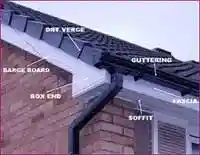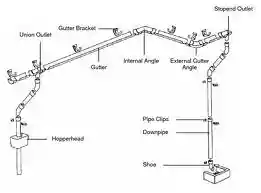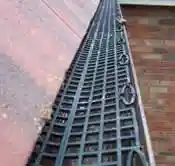












 A rain gutter is a narrow channel that is part of the roofing system of a building. Its purpose is to collect and divert rainwater that is collected from the roof. In some parts of the world it can be referred to as an eavestrough, eaves channel, gutter or guttering.
A rain gutter is a narrow channel that is part of the roofing system of a building. Its purpose is to collect and divert rainwater that is collected from the roof. In some parts of the world it can be referred to as an eavestrough, eaves channel, gutter or guttering. Gutters also helps to protect painted surfaces around the eaves by reducing exposure to water.
Gutters also helps to protect painted surfaces around the eaves by reducing exposure to water. Gutters must be maintained regularly to remove leaves, moss, tennis balls and other debris to keep them from bloccking. Gutters that are clogged with debris can overflow and soak the foundation and damage the roof structure. Gutter guards that keep debris out can be installed, thay still allow water to enter and flow along the guttering.
Regardless of the gutter guard protection used, all gutter systems should be examined for cleaning and repair every year.
Gutters must be maintained regularly to remove leaves, moss, tennis balls and other debris to keep them from bloccking. Gutters that are clogged with debris can overflow and soak the foundation and damage the roof structure. Gutter guards that keep debris out can be installed, thay still allow water to enter and flow along the guttering.
Regardless of the gutter guard protection used, all gutter systems should be examined for cleaning and repair every year.As described in the 1911, 11th edition of the Encyclopedia Britanica:
GUTTER (0. Fr. goutiere, mod. gouttiere, from Lat. gutta,* drop), in architecture, a horizontal channel or trough contrived to carry away the water from a flat or sloping roof to its discharge down a vertical pipe or through a spout or gargoyle; more specifically, but loosely, the similar channel at the side of a street, below the pavement. In Greek and Roman temples the cymatium of the cornice was the gutter, and the water was discharged through the mouths of lions, whose heads were carved on the same. Sometimes the cymatium was not carried along the flanks of a temple, in which case the rain fell off the lower edge of the roof tiles. In medieval work the gutter rested partly on the top of the wall and partly on corbel tables, and the water was discharged through gargoyles. Sometimes, however, a parapet or pierced balustrade was carried on the corbel table enclosing the gutter. In buildings of a more ordinary class the parapet is only a continuation of the wall below, and the gutter is set back and carried in a trough resting on the lower end of the roof timbers. The safest course is to have an eaves gutter which projects more or less in front of the wall and is secured to and carried by the rafters of the roof. In Renaissance architecture generally the pierced balustrade of the Gothic and transition work was replaced by a balustrade with vertical balusters. In France a compromise was effected, whereby instead of the horizontal coping of the ordinary balustrade a richly carved cresting was employed, of which the earliest example is in the first court of the Louvre by Pierre Lescot. This exists throughout the French Renaissance, and it is one of its chief characteristic features.